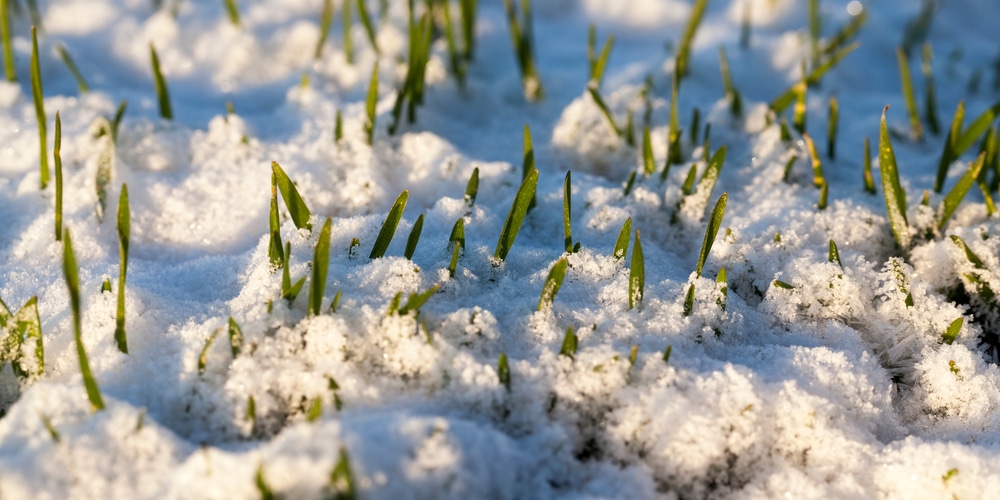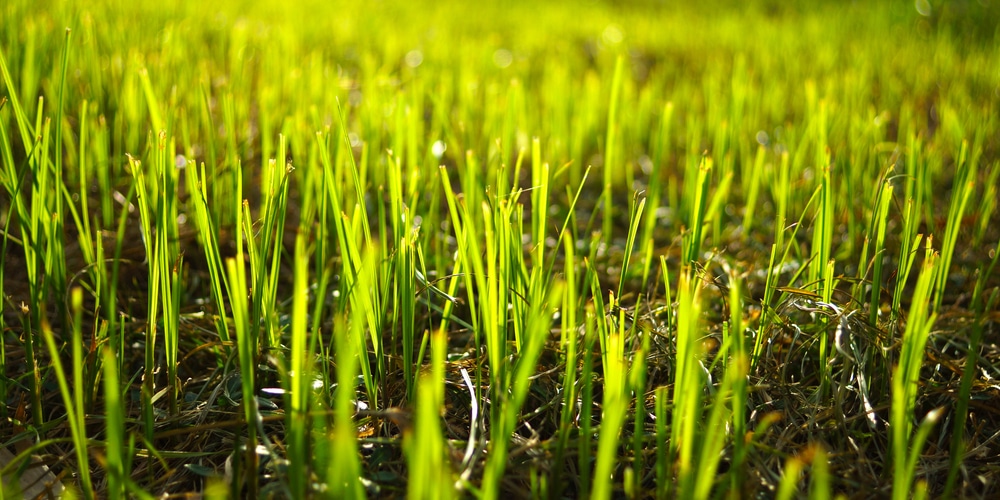Your grass has had a long and arduous journey this year. It started out as a small seed, barely noticeable in the soil. But with some TLC (and a lot of water), it grew into a lush green lawn. Congratulations!
But now winter is looming on the horizon, and you’re worried about how to protect your new grass from frost damage. Don’t worry – we’ve got you covered! In this blog post, we will discuss how to protect your lawn from frost damage and help it survive the winter months.
How Much Frost Can New Grass Tolerate?

The first frost of the season is always a bittersweet moment. On the one hand, it marks the end of summer and the start of cooler weather. On the other hand, it can damage delicate new grass.
So, how much frost can new grass tolerate? The answer depends on the type of grass and the severity of the frost.
Some grasses, such as bluegrass and ryegrass, are more tolerant of cold weather and can withstand light frosts with little damage.
However, other grasses, such as bermudagrass and zoysiagrass, are less tolerant of frost and may suffer from dieback or discoloration after a hard freeze.
When deciding whether or not to protect your lawn from frost, you should also consider the severity of the frost. A light frost, which typically occurs when temperatures dip below 32 degrees Fahrenheit, will not cause significant damage to most grasses.
However, a hard frost, which occurs when temperatures dip below 28 degrees Fahrenheit, can damage even the most tolerant grasses.
So, what can you do to protect your new grass from frost damage? Read on for our tips on winterproofing your lawn!
What is Frost Damage, and What Are the Signs?
Winter can be a challenging time for plants, grasses included. The cold weather, combined with the lack of sunlight, can make it difficult for them to stay healthy.
One of the biggest dangers they face is frost damage. Frost damage occurs when the temperature drops low enough to cause the water in plant cells to freeze. This can cause the cells to rupture, leading to wilting and discoloration of the plant.
There are a few signs that you can look for to tell if your grass is suffering from frost damage. Understanding these signs will help you take steps to prevent further damage and, hopefully, save your lawn.
Some of the most common signs of frost damage are:
Wilting or Drooping Leaves
Wilting or drooping leaves is one of the most common and easiest ways to tell if your grass has been frost-damaged. When leaves wilt, they turn a yellow-brown color and droop down. If they remain wilted for more than a day or two, this is a sign that the plant has been severely damaged and may not recover.
Appears Bent
The next way to tell if your grass has suffered from frost damage is by looking at the blades of grass themselves. If they are bent over at an angle or appear broken, this is another sign of frost damage. The edges of grass will also appear dull and lifeless if they have been damaged by frost.
Discoloration
Another common sign of frost damage is discoloration of the leaves. Frost-damaged leaves will often turn brown or black and may appear wilted or dried out. This is due to the fact that frost damages the cells in the leaves, causing them to die.
How to Protect New Grass from Frost Damage
Now that you know how to identify frost damage, it’s time to learn how to protect your grass from it. Here are a few tips:
Water Regularly and Deeply
One of the most important things you can do is to water regularly and deeply. This will help the grassroots to grow deep and strong, so they can better withstand the cold weather.
Make sure to water in the early morning or evening so the sun doesn’t evaporate the water too quickly. And be sure to check the forecast before watering, so you don’t accidentally water when a freeze is predicted.
Fertilize Your Lawn Before the First Frost
Another helpful tip is to fertilize your lawn before the first frost hits. This will give the grass a boost of nutrients that will help it to survive the winter. Be sure to choose a fertilizer that’s designed for cool-season grasses, such as Kentucky bluegrass or fescue.
Add a Layer of Mulch
A layer of mulch helps to insulate the ground and protect new grass from frost damage. The best time to apply a layer of mulch is in late fall after the ground has been cleared of leaves and other debris.
An ideal mulch should be at least two inches thick and made of organic material such as wood chips or straw.
Once the mulch has been applied, water it thoroughly to help it settle into place. In addition to providing insulation, mulch also helps to suppress weed growth and keep the soil moist.
As a result, it can play an important role in protecting new grass from frost damage.
If you know a freeze is coming, you can protect your grass by covering it with a layer of straw. This will insulate the grass and prevent it from being damaged by frost. Just be sure to remove the straw once the weather warms up, so your grass can get the sunlight it needs to grow.
Final Thoughts: Helping New Grasses Survive the Frost
In the bleak days of winter, the grasses huddle together, stiff and straw-like. They seem to be barely hanging on, waiting for the warmth of spring. But appearances can be deceiving.
These grasses are actually in a state of dormancy, a survival mechanism that allows them to endure the cold months.
During dormancy, the grasses stop growing and go into a state of suspended animation. Their metabolism slows down, and they stop taking in water. This helps them survive periods of extreme cold when their water supply would otherwise be cut off by frozen soil.
When the temperatures start to rise again, the grasses come out of dormancy and start growing once more. However, this transition period can be dangerous for young grasses.
Their blades are still tender and vulnerable to damage from frost or snow. That’s why it’s crucial to give new grasses a little extra protection during their first winter.
As mentioned earlier, a layer of mulch can help to insulate the ground and protect new grasses from frost damage. You can also water regularly and deeply to help the grassroots grow deep and strong. And finally, be sure to fertilize your lawn before the first frost hits.
By taking these steps, you can help new grasses survive the frost and thrive in the springtime.
Related Article: Will Frost Kill Geraniums?

